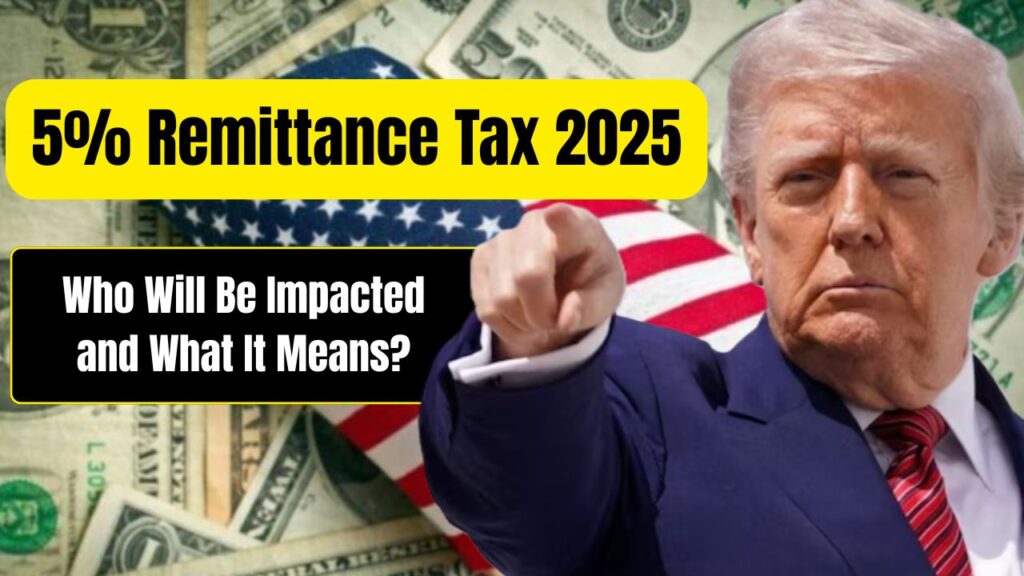5% Remittance Tax 2025: Millions of Indians are working in the U.S. The families who are living here and one of them is working is U.S normally send money to his family and India is in the top three immigrant country in the U.S. Indians are working there and sending money to their families living in India. A new proposal has been introduced for India Remittance Tax Update, that U.S may levee taxes on every international money transfer made by non-citizens.
Many Indian families are relying on the support they are getting from the relatives who are working in the US, and the implementation of the new law could lead to a significant new expense and change the flow of funds for education, healthcare, and daily needs. With this introduction of new plan of 5% tax on remittance who will be affected?
The answer is the NRIs, H-1B workers, international students, and all other non-US citizens including those with US Green Cards will be directly affected by the new law that imposes a 5% tax on remittances. Each time an immigrant sends money overseas or to the families, the US Treasury will receive a portion of the remitted amount as tax.
New 5% tax on foreign remittance 2025 – How it will make work?
Let’s analyse an example. If anyone who is living in the USA and he wants to transfer Rs. 2 lakh to his family living in India, then he will be imposed $120 as tax of remittance. Authorized remittance transfer providers will collect this tax and send it to the Secretary of the Treasury on a quarterly basis. The new bill will impose a 5% of tax on any remittances made by individuals in the US who are not officially recognized as citizens or nationals as abided by the law.
(FFESP) $725 Family First Economic Support Program Payment Schedule and Program Duration
$1000 Baby Benefits for Every Newborn With Just Only 1 Criteria, Check New Rules
Is 5% Tax applicable to all- Who will be affected?
- With this implementation of the law, some particular categorized person will be affected. It will not affect the US citizens or nationals, as long as they use a ‘qualified remittance transfer provider’ for their payments.
- If we see the scenario of Indians, then as we know that the Indians living in the US are known to send millions of dollars back home to support their families living in India and to make investment in their own native country from where they belong. So here the imposition of 5 % will increase the cost of sending money to India and will lessen the frequency.
- For this there will be reduction in remittances or the frequency of sending amount will be reduced especially for the middle-income group.
- Wealthy individuals may find it easier to afford the cost but for a large sample of the population particularly for the middle class, it could burden their financial planning and investment.
The idea of Introduction of this Proposal and Why?
This proposed bill is a part of the One Big Beautiful Bill Act. It was introduced in the U.S. House of Representatives on May 12, 2025. 5% Remittance Tax 2025 is a bill of president’s legislative agenda whichis being carry forwarded by the House Ways and Means Committee and approved by the House Budget Committee on May 18th of 2025.
Money Transfer Tax Purpose
In order to increase the revenue for implementation of domestic initiatives such as strengthening border controls and increasing defense expenditures. The imposition is meant to strengthen the immigration policies for non-citizens who are moving to the U.S for staying and working. This introduction of tax is a part of strategy to stabilize the stay of those who are already residing in the country and being sending amount to their families.
$100 Million Social Security Fraud Exposed, Case Update and Full Details
Is Wells Fargo Shutting Down Accounts June 2025? Everything You Should Know
How it will affect the Indian Economy?
- The NRIs are the major senders of U.S. dollars who have put their money into the Indian stock market, mutual funds, and real estate.
- As we know that remittance includes the transferring of funds by the NRIs to their parents in India, supporting their children’s education, settling loan EMIs, or investing in real estate.
- There are more than 5 million of NRIs belong to Indian origin who are living in the U.S and sending more than $ 30 billion in remittances to India in 2023-24 as per a report.
- With the imposition of tax, it will affect a large segment of the 28% of India’s $118.7 billion remittance inflows, as stated by Sonam Chandwani, Managing Partner at KS Legal & Associates.
- The remittance inflow will be lower in the upcoming years and this will turn as a major financial challenges for both the NRIs and the Indian Economy.
- These remittances typically come from post-tax income that has already been taxed by U.S. federal and state authorities.
- The tax directly cuts down the funds available for vital expenses in India, such as healthcare, education, or housing.
How the NRIs will prepare themselves to manage the U.S. remittance tax?
As far as now, the remittance bill is still just a proposal and hasn’t become a law yet. So the families or the NRIs have the enough time to prepare themselves to face the mandate before its implementation. They just have to follow certain steps like, they have to keep records of all money transfers to India from the USA. This will help them at the time of tax-filling.
The NRIs have to check their citizenship and visa status, as it impacts tax exemption eligibility. Keep updated yourself about the proposed remittance tax being considered by Congress. Get in touch with a remittance service that follows regulations and is cost-effective for sending money to India.






